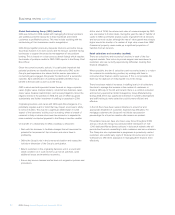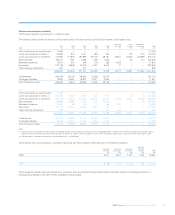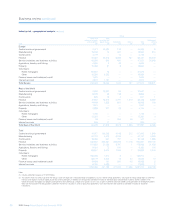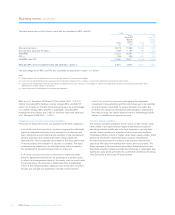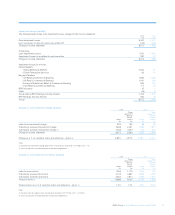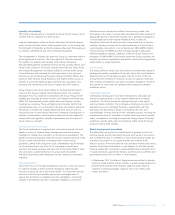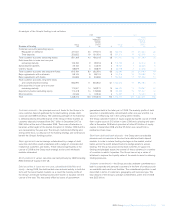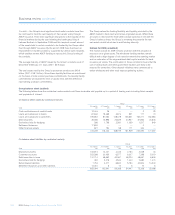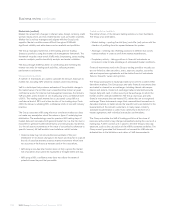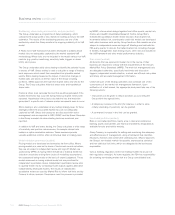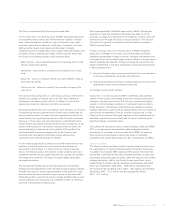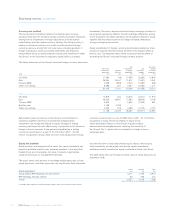RBS 2008 Annual Report Download - page 105
Download and view the complete annual report
Please find page 105 of the 2008 RBS annual report below. You can navigate through the pages in the report by either clicking on the pages listed below, or by using the keyword search tool below to find specific information within the annual report.
104
Business review continued
RBS Group Annual Report and Accounts 2008
•In April 2008, the Bank of England launched a special liquidity
scheme allowing banks to swap temporarily illiquid mortgage and
other assets for Treasury Bills. The scheme closed to new issuances
on 30 January 2009. However, it will provide liquidity support for a
further three years.
•In September 2008, the major central banks announced coordinated
action to improve US$ liquidity. As part of this action, the Bank of
England and ECB commenced US dollar repo operations. Eligible
collateral consists of securities routinely eligible in the Bank of
England’s and ECB’s short-term repo open market operations
together with conventional US Treasuries. The Bank of England
concluded a reciprocal swap agreement (swap line) with the US
Federal Reserve. On 3 February 2009, the Bank of England
announced the extension of this facility until 30 October 2009.
•In October 2008, the pool of eligible collateral securities for its open
market operations was extended to include bank debt guaranteed
under the Government’s bank debt guarantee scheme.
•In October 2008, the Government announced a credit guarantee
scheme. It will guarantee new unsecured borrowing in return for a
fee. Initially the guarantee period ended on 9 April 2009 but on 19
January 2009 the Government announced an extension to 31
December 2009. It also announced new arrangements, expected to
start in April 2009, to guarantee asset-backed securities issued by
banks.
•In October 2008 the European Central Bank expanded its list of
eligible collateral to include marketable debt instruments
denominated in non-euro currencies (and issued in the euro area)
among others. This is to remain in force until the end of 2009.
Enhancements were also made to the provision of longer-term
refinancing operations including conducting them through a fixed rate
tender procedure with full allotment. This is to stay in place for as
long as needed and at least until 31 March 2009.
•On 27 October 2008 the Federal Reserve Bank commenced the
Commercial Paper Funding Facility to provide a liquidity backstop to
issuers of commercial paper. A special purpose vehicle (SPV) funded
by the Federal Reserve Bank of New York will purchase eligible three-
month unsecured and asset-backed commercial paper from eligible
issuers. In February 2009 the FED announced an extension to this
facility until 30 October 2009.
•In October 2008 the UK Government announced recapitalisation
plans for a number of UK banks including RBS.
•In January 2009, it was announced that the Bank of England will
permit drawings from the discount window facility with a term of 364
days, in addition to the standard option to draw for 30 days.
•In January 2009, the Government announced that the Bank of
England had been authorised to purchase up to £50 billion of high-
quality private sector assets under an asset purchase facility. The
following sterling assets are initially eligible for purchase: commercial
paper, corporate bonds, paper issued under the Credit Guarantee
Scheme (CGS), syndicated loans and asset-backed securities
created in viable securitisation structures.
•In January 2009, the Government announced an asset protection
scheme. The Government will insure, for a commercial fee, certain
bank assets against losses. It is anticipated that the scheme will
commence in April 2009. The UK banks, including the Group, have
been in discussions with the Tripartite Authorities about the scheme’s
terms.
•In January 2009, the FSA has announced that it will ensure that the
application of the current International Basel Accord does not create
any unnecessary or unintended pro-cyclical effects.
•On 3 February 2009 the Federal Reserve Bank announced an
extension to a number of its liquidity facilities until 30 October 2009.
These included the Term Securities Lending Facility (TSLF), originally
announced in March 2008. Under the TSLF, the Federal Reserve Bank
of New York auctions 28-day term loans of Treasury securities to
primary dealers in exchange for other program eligible collateral.
Liquidity management in 2008 (audited)
The exposure of the Group to wholesale market funding increased
markedly in 2008 following the acquisition of the wholesale banking
business of ABN AMRO in the latter half of 2007. The amount of
unsecured wholesale funding represented by bank funding and debt
securities increased from £154 billion in June 2007 to £362 billion in
December 2007. The gap between customer loans and customer
deposits increased over this period from £86 billion to £121 billion.
The market disruption during 2008 had a marked effect on the Group’s
liquidity and funding which was at its most acute in the autumn of 2008
following the collapse of Lehman Brothers. During that period, the
Group’s credit ratings were downgraded constraining both access to
and tenor of wholesale funding and there was an outflow of customer
deposits. The effective closure of the term funding markets and sharp
reduction in the quantity and maturity of short term bank funding had
profound consequences for the Group.
Whilst the Group’s customer funding sources remain well diversified and
its retail franchise proved resilient, the availability of longer term funding
diminished. The Group therefore increased its shorter term wholesale
funding exposure, increased its access to central bank funding and
issued government guaranteed debt to fund the balance sheet. The
government schemes have enabled the mitigation of the financial crisis
as the Group rebalances its asset and liability structure.


